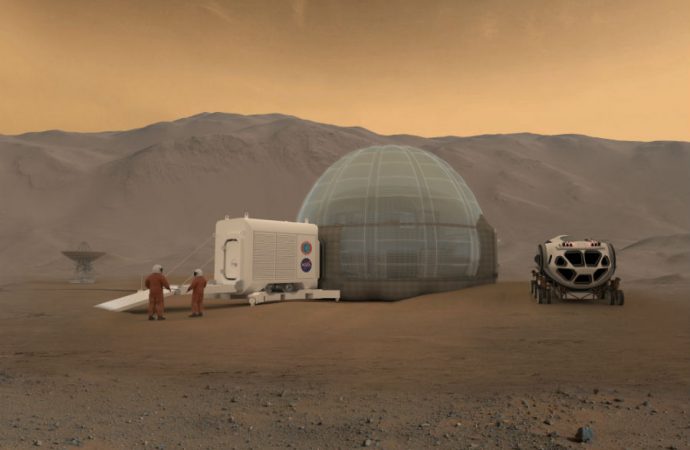NASA’s latest plan: ‘Mars Ice Home’ could be the key to providing astronauts with a place to stay for months on end while living on the Red Planet.
NASA’s plan to send astronauts to Mars within the next few decades still faces several challenges before humans can actually set foot on the red planet. One of the most significant problems is providing shelter for human explorers on the planet that can safely house them for long periods of time in a completely alien environment.
Now, researchers think they have come up with a potential building material that could be the solution to many of the problems associated with Martian living conditions: ordinary ice.
Of course, these extraterrestrial igloos would be a little more sophisticated than their Earth-based counterparts, and there are still a few considerations to take into account in order to make their design fully viable for habitation. But the researchers believe that ice, one of the most basic building materials ever used by humans, could provide engineering solutions to many problems that more “advanced” building materials are unable to provide.
The design concept for the so-called “Mars Ice Home” was unveiled by NASA’s Langley Research Center in Hampton, Va., with assistance from Space Exploration Architecture and the Clouds Architecture Office. The Langley scientists developed the concept inspired by a design by these two organizations that won a NASA Centennial Challenge last year for a 3-D-printed Martian habitat that used ice as a building material.
“After a day dedicated to identifying needs, goals, and constraints we rapidly assessed many crazy, out of the box ideas and finally converged on the current Ice Home design, which provides a sound engineering solution,” Langley senior systems engineer Kevin Vipavetz, who facilitated the design session, said in a NASA statement.
Designing homes for astronauts on Mars is more difficult than it might sound. Unlike the missions to the moon, the length of the trip to Mars means that the first visitors to the red planet will have to stay for months longer than their Apollo counterparts. They will need more room for supplies and expanded living space that cannot be provided in a cramped Martian lander, and their homes would have to take a lot of punishment.
“The materials that make up the Ice Home will have to withstand many years of use in the harsh Martian environment, including ultraviolet radiation, charged-particle radiation, possibly some atomic oxygen, perchlorates, as well as dust storms – although not as fierce as in the movie ‘The Martian’,” said Langley researcher Sheila Ann Thibeault in the statement.
Building a larger habitat with traditional building materials would certainly do the trick, but it would require large amounts of labor and massive payloads from Earth. But ice may be just the right material to keep astronauts safe and comfortable – and since Mars is thought to have abundant ice just below the surface, there will plenty of building materials nearby.
The Mars Ice Home would be made up of an inflatable material, similar to an inner tube, that the astronauts would actually live inside. The outside would be encased in a shell of ice, which would protect the interior structure from many of the problems associated with the Martian environment, including cosmic rays, one of the biggest concerns about living on Mars. Long-term exposure to such radiation carries significant health risks for human beings. These rays could be avoided by building shelters underground, but that would require huge robotic excavators to be transported from Earth. But water-based ice is very effective at blocking radiation without driving astronauts into hiding underground.
“All of the materials we’ve selected are translucent, so some outside daylight can pass through and make it feel like you’re in a home and not a cave,” Ice Home principal investigator Kevin Kempton said in the statement.
Other advantages for the Ice Home include the structure’s potential lightness. Since the structure is inflatable, it can be moved easily via spaceship from Earth and across the Martian surface by robot. Since the structure also incorporates ice from Mars itself, it could be filled with water relatively easily, before human explorers even arrive on the planet. The ice surrounding the structure could even be used as a storage tank of sorts, since the Mars Ascent Vehicle could be powered by rocket fuel converted from ordinary H2O.
“When we go to Mars, we will stay there for a long time,” Dr. Kempton told Space.com. “We will need a place to service the robotic equipment that will be out there working for us in very difficult environments.”
Source: The Christian Science Monitor

































Leave a Comment
You must be logged in to post a comment.